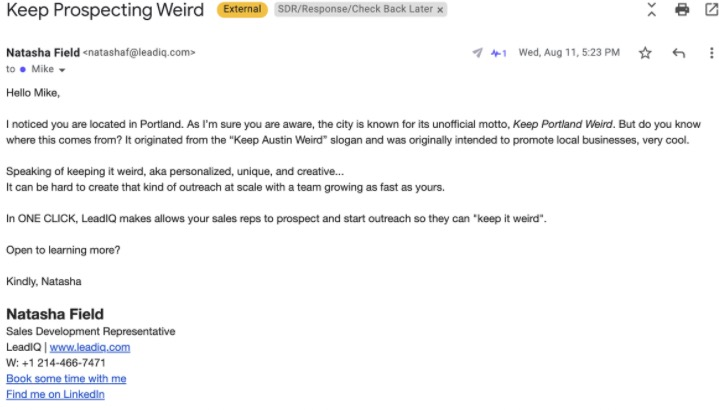Ready to create more pipeline?
Get a demo and discover why thousands of SDR and Sales teams trust LeadIQ to help them build pipeline confidently.





Get a demo and discover why thousands of SDR and Sales teams trust LeadIQ to help them build pipeline confidently.
If you’re still sending the same templated emails to your prospects, chances are you’re doing more harm than good. Templated emails rarely contain a message that works for breaking into the majority of accounts—even if they rely on other marketing techniques, like A/B testing.
With less than 1% of cold emails receiving a response these days, reply rates have never been lower. Why? Because your prospects, who are saddled with more communication responsibilities than ever, have been trained to ignore you.
To fight through the rest of the noise that’s flooding your prospect’s inboxes, you need to do whatever you can to stand out. The good news is that writing a great email is not as hard as you might think.
There are three levels of engagement for writing a personalized email. Let’s call them:
I’ll break down each of these approaches throughout this post, but will start by sharing this truth: if you’re reaching out to someone, it should be clear from the start that the person can legitimately benefit from your product or service. If that’s not the case, you should not be sending them an email.
That being said, the first rule of cold-email engagement is: Always do your research!
Start at the account level and follow these steps:
All of these activities will help you—not only with your initial outreach—but throughout the entire sales process. That’s because doing this research provides you with information that can be used at different points in your sequence.
Even if you write amazing cold emails, you’re still not going to hear back from at least two-thirds of the recipients on the first touch. That being said, make sure you have plenty of info in your back pocket for future outreach...
Once you’ve conducted the research listed above, it’s time to start researching the prospects themselves. Open up Sales Navigator and narrow down your search results. If you have a tool like LeadIQ and a Sales Engagement Platform, you can add these people and all of their necessary contact data into the proper Sequence/Cadence right from this view. Next, choose one person and open up their LinkedIn profile.
Scan through their profile. While most of the information you see can be useful, be sure to check out the Activity and About sections first, as these sections often yield the richest information. Don’t forget to look at any Recommendations, as this area can reveal personal details (such as the prospect’s preferred name). A quick Google search can also prove fruitful.
No matter how much information you find on a prospect, you should be able to answer these four questions:
If you find anything that you have in common with your prospect or something that has legitimately piqued your interest—cool. You now have enough information for the most effective form of personalization, Personalization 3.0.

Let’s say, on the other hand, that you don’t have anything in common with the prospect, but you see a few things that they might be passionate about. You already have a decent understanding of their role and the challenges they regularly face, but you know that taking your insights one step further will increase the chance of a response.
In this scenario, you can look at things like where they went to college, where they live, how long they’ve been with the company, previous roles, other companies they’ve worked at in the past, job posts, company news, LinkedIn posts, etc. You can then place the information you find in the subject line and the first sentence of an email.
The prospect (hopefully) will be so intrigued by the personal touch that they will open and read your email. That’s the method for writing a Personalization 2.0 email.

If the person you’re researching doesn’t share much information in their online profiles, and a Google search leads you to nothing but an endless rabbit hole into the deep dark abyss of Facebook and Twitter, then your next best bet will be demonstrating an understanding of the company they work for, as well as their role.
Relevance is the keyword for Personalization 1.0 emails, and it works by showing the prospect that you understand and can meet the needs specific to them and their business.
A great way to write a relevant cold email is by talking about a customer that is similar to the prospect, and how your company + product successfully solved a problem that customer faced while also mentioning something you’ve noticed about their company or team.

This email finds a relevant point of interest between the prospect and an ongoing client. It demonstrates:
a) your ability to relate to the prospect
b) your company’s competence
c) a reason for the prospect to get in touch.
This type of email will stand out from templated emails, and give you and your company a competitive advantage. Do your research, stay personal, and stay relevant. That’s the secret recipe for writing a cold email that reaps rewards.
Happy prospecting.
Subscribe for updates.